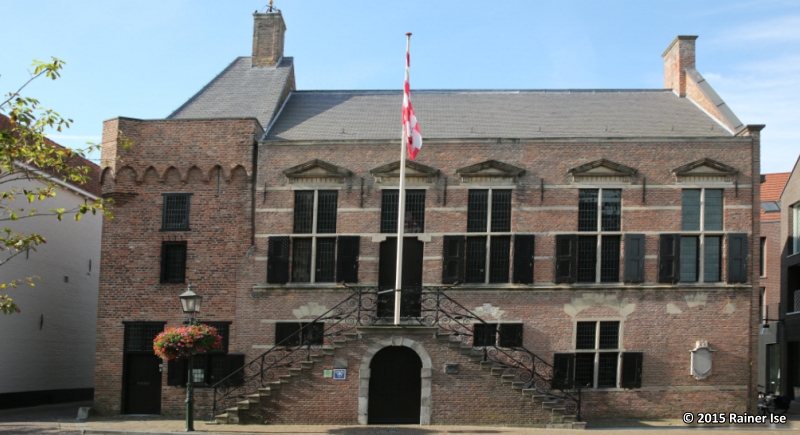
|
GEO-KOORDINATEN |
|
51.75936°
N / 5.73747° O |
 |
|
Adresse:
Trompeterstraat
5361
Grave |
 |
| |
Der Autor besuchte Grave zur Foto-Session am 06. 08.
2015 |
|
NO |
| |




|
Die Geschichte von Grave |
|
|
"Grave war die meist belagerte Stadt in den Niederlanden",
wird manchmal von Grave behauptet. Ob diese Behauptung richtig ist, kann nicht
mit Sicherheit festgestellt werden. Grave hat aber ohne Zweifel eine bewegte
Vergangenheit. Die Stadt wurde oft in Trümmer geschossen und genauso oft
wieder aufgebaut. |
|
|
|
|
|
Die Geschichte von Grave beginnt um 1140. Sieben Jahre
davor (1133) wurde Floris de Zwarte von den Gebrüdern Godfried und Herman,
den Herren von Kuyc (lesen Sie: Kük), ermordet. Der deutsche Kaiser
Lothar, Lehnsherr des Grundbesitzes der Herren von Kuyc, konnte diese Freveltat
nicht ungestraft lassen. Lothar verbannte die Gebrüder von ihrer Burg in
Cuijk, die er völlig zerstören ließ. Nach dem Tod des deutschen
Kaisers (1137) konnten die Gebrüder aber zurückkehren. Sie wollten
ihre zerstörte Burg wieder aufbauen, aber nicht mehr in Cuijk, sondern in
Grave. Dieses Gebiet war nämlich kein Lehen, sondern ihr Eigentum. Um 1140
wurde mit dem Bau begonnen und schon bald entstanden um die neu errichtete Burg
die ersten Siedlungen: der Ursprung von Grave.
Die Herren von Kuyc waren
bis 1400 Machthaber im "Land van Cuijk" und daher auch in Grave.
Voraussichtlich verliehen sie Grave um 1350 Stadtrechte, aber das ist nicht
genau bekannt. Die Herren von Kuyc bedeuteten viel für Grave. Sie
stifteten rund 1245 die St. Elisabethkirche und bald darauf den Beginenhof.
Große Bedeutung erlangte auch Jan I. van Kuyc. Er stiftete 1290 das St.
Catharina-Hospital und veranlasste 1308, dass die St. Elisabethkirche zur
Stiftskirche erhoben wurde. Aufgrund der Drohung, die von Gelre (Geldern) am
anderen Ufer der Maas ausging, ließ er 1285 eine Befestigung um die Stadt
Grave bauen. Hiermit war der Grund für den späteren Festungsbau
gelegt, der die Geschichte von Grave so stark geprägt hat. Belagerungen
und Eroberungen waren gang und gäbe. Grave wird in den nächsten
Jahrhunderten verschiedene schwere Kriege ertragen müssen.
Die
erste Belagerung der Stadt Grave fand bereits 1286 statt, als sie vom
nachbarlichen Gelre bedrängt wurde. 1323 wurde die Stadt ein Brabanter
Lehen. 1400 gelang Willem van Gulik, Herzog von Gelre, während des
Machtkampfs zwischen Gelre und Grave in den Besitz von Grave, obgleich die
Stadt ein Lehen von Brabant blieb. An historischer Bedeutung gewann Grave durch
Herzog Arnoud van Gelre. Er wurde 1465 von seinem Sohn Adolf entführt und
in Buren gefangen gehalten. Erst 1471 wurde er von Karl dem Kühnen von
Burgund befreit. Bevor er starb, schenkte er Karl dem Kühnen aus
Dankbarkeit sein Gebiet. Verschiedene Städte und vor allem Adolfs Sohn,
Karl van Gelre, leisteten ihm noch bis 1536 Widerstand.
Während des
Achtzigjährigen Krieges wurde Grave zweimal belagert und erobert,
zunächst von den Spaniern unter Parma (1586) und später von Prinz
Moritz von Nassau-Oranien (1602), dem Statthalter der Vereinigten Niederlande.
1672 ging Grave in die Hände von Ludwig XIV., König von Frankreich,
über. Nach zwei Jahren konnte Grave von den Landstreitkräften
zurückerobert werden. Die Franzosen leisteten heftigen Widerstand, dabei
fielen unter den Angriffstruppen wohlgemerkt 16.000 (!) Opfer, bevor sie Grave
übergaben. Die Stadt bestand zum Großteil nur noch aus
Trümmern.
Nach dieser schweren Belagerung wurden die Festungswerke
gründlich erneuert. Die Burg wurde abgerissen und das Hamtor erbaut. Noch
zweimal war Grave Belagerungen und Beschießungen ausgesetzt; 1794
verteidigte General De Bons die Stadt wiederum gegen die Franzosen. Nach
einigen Wochen musste er den Kampf aufgeben. Wieder war die Stadt ein
Trümmerfeld. Erst 1874 wurde Grave als Festungsstadt aufgegeben und mit
der Entfestigung der Stadt begonnen. Es sollten lediglich Ruinen erhalten
bleiben. Derzeit bemüht sich die Stadtverwaltung um den Erhalt und die
Instandsetzung historischer Überreste. Es wird ein Plan erarbeitet, um
kostengünstig möglichst viele, historische Festungswerke
zurückzubringen, bildlich vorzustellen oder zu markieren.
Grave
liegt an der Maas. Die jährlich wiederkehrenden Überschwemmungen des
Überlaufgebietes "Beersche Maas", in das das Hochwasser abfloss, hinderten
die Entfaltung und Entwicklung von Grave. Nicht nur Grave, sondern auch das
ganze umliegende Land war dann überschwemmt, wodurch die Stadt vollkommen
isoliert war. Mit der Kanalisierung der Maas und dem Bau der Staubrücke
über die Maas in den 1920er-Jahren gehörte dieses Problem der
Vergangenheit an.
Die Kriegsgefahr brachte die Garnison 1938 wieder nach
Grave zurück. Die Truppen wurden aber nicht in der alten Festungsstadt,
sondern in der in Velp gebauten "General de Bons"-Kaserne untergebracht. Trotz
der bedeutungsschweren Rolle, die die Staubrücke über der Maas beim
Manöver "Market Garden" spielte, hat die Stadt Grave den Zweiten Weltkrieg
nahezu unbeschädigt überstanden. Grave wurde am 17. September 1944
von der 82. Amerikanischen Airborne Division befreit. In den Kriegsjahren
wurden die Kirchdörfer Escharen und Velp in die Gemeinde Grave
eingegliedert.
Nach 1945 fing man an, die Stadt hinter den Wällen
auszubauen. Neue Stadtteile entstanden, zunächst Mars mit dem sogenannten
Roten und Blauen Dorf. Danach folgten Zittert, Estersveld und Stoof.
Die
Altstadt von Grave zählt noch viele historische Gebäude und
Wohnhäuser, viele davon sind denkmalgeschützt. Obschon eine Sanierung
und Restaurierung für die Gemeinde und Bürger mit hohen Kosten
verbunden war und noch ist, waren diese Arbeiten unerlässlich und sie
wurden denn auch rigoros in Angriff genommen. Seit 1975 erntet man die
Früchte dieser jahrenlangen Arbeit. Viele Restaurierungen sind fertig
gestellt und verleihen der Stadt Grave zusammen mit den Neubauten wieder die
Atmosphäre früherer Zeiten. |
|
|
Quelle:
grave.nl |
|
|
|
|
|
History of Grave |
|
|
"Grave is the most-often besieged fortified town in the
Netherlands." This is a claim often made about Grave. Whether or not it is
true, is not entirely clear. What is, however, clear is that Grave has an
interesting past. The town has been reduced to rubble on many occasions, and
has been rebuilt just as often. |
|
|
|
|
|
The history of Grave dates back to around 1140. Seven years
prior, in 1133, Floris de Zwarte ("Floris the Black") was murdered there by the
"Lords of Kuyc (pronounced: Kuuk)," the brothers Godfried and Herman. The
German emperor Lotharius, from whom the Lords of Kuyc had borrowed money to
finance their possessions, could not let this crime go unpunished. Lotharius
had their castle in Cuijk destroyed and both brothers were banished. When the
German emperor died in 1137, the brothers were permitted to return. They wished
to rebuild their ruined castle, but this time in Grave, instead of Cuijk. This
area was actually one of their personal possessions rather than just one on
loan. The reconstruction took place around the year 1140, and the first
settlements quickly sprouted up around the rebuilt castle. These events are
considered to be the origin of Grave.
Until 1400, the Lords of Kuyc
remained the rulers in the Land of Cuijk, and thus also in Grave. It is not
known when they granted a charter to Grave, yet this must have occurred around
the middle of the 13th century. The Lords of Kuyc were very important for
Grave. They were the founders of the St. Elisabeth Church around 1245, and
shortly thereafter, the beguinage. Jan 1 of Kuyc was also a significant
historical figure. He founded the St. Catharina Hospital in 1290, and, under
his rule, the St. Elisabeth Church's status was raised to that of a collegiate
church in 1308. In 1285 he had the town of Grave fortified due to the threat
originating from the Gelre area on the other side of the Maas. With this the
foundations were laid for the later fortifications which left such a clear mark
on the history of Grave. Siege and conquest became the order of the day, and in
the centuries that followed, Grave would have to suffer through various major
wars.
The first siege took place in 1286 when the neighbouring region of
Gelre threatened. In 1323, the town of Grave became a fief of Brabant. In the
power struggle between Gelre and Brabant, the city of Grave came into the
possession of Willem of Gulik, Duke of Gelre in 1400, even though the city
remained a fief of Brabant. Duke Arnoud of Gelre became important for Grave. In
1465 he was kidnapped by his son Adolf and imprisoned in Buren. He was not
freed until 1471 by the Burgundian Charles the Bold. Just before his death, he
conferred his area to Charles the Bold out of gratitude. The resistance to this
by various towns, but in particular by Adolf's son, Charles of Gelre, lasted
until 1536.
During the Eighty Years' War, Grave was subjected to siege
and conquest twice, the first being in 1586 by the Spaniards under Parma, and
again in 1602 by Prince Maurits, governor of the United Netherlands. In 1672
Grave was turned over to Louis XIV, King of France. Two years later, the
National army succeeded in regaining possession of Grave. The French put up a
fierce resistance however, and managed to claim the lives of 16,000 of those
among the attacking troops before they finally surrendered their claim to
Grave. Ultimately there were more soldiers' lives taken than spared by the end
of the struggle.
After this heavy siege, the fortifications were
thoroughly renovated. The castle disappeared, and the Hampoort was built. Grave
was subjected to siege and bombardment one more time; in 1794, General De Bons
defended the city against, once again, the French. After several weeks, he was
forced to give up the fight. Once again, the town lay in ruins. It was not
until 1874 that Grave's status as a fortified town was abolished, and the
dismantling of the fortifications began. Only small remnants would remain
preserved. Nowadays, the district council still attempts to restore and
preserve that which remains. A plan is in the works to return the former
fortifications, as much as is possible - and is affordable - to their original
state or to otherwise create a visual display, or at least mark their original
location.
Grave is located on the Maas. The annual returning floods from
the Beersche Maas, an overflow dam which became operational during high tides,
formed an impediment to the expansion and development of Grave. During these
high water events, the entire area surrounding Grave would become flooded,
completely isolating the town. With the canalisation of the Maas and the
construction of the weir bridge over the Maas in the 1920's, this problem of
flooding was resolved.
In 1938, the threat of war brought the garrison
back to Grave. The troops were however not housed in the old fortified town,
but instead in the General De Bons barracks built in Velp. Although the weir
bridge over the Maas played an important role in Operation Market Garden, for
all intents and purposes, the town of Grave survived World War II intact. Grave
was liberated on 17 September 1944 by the United States' 82nd Airborne
Division. During the war years, the parishes of Escharen and Velp were added to
the municipality of Grave.
After 1945, the town's expansion outside of
its walls was begun. The first district which arose was the Mars with its
so-called Red and Blue village. Other districts followed later such as the
Zittert, the Esterveld and the Stoof.
Grave's city centre still boasts
many old buildings and homes, many of which have been designated as monuments.
Redevelopment and restoration were direly necessary and were approached
rigourously in spite of the fact that this involves, and continues to involve,
enormous costs for the municipality and the citizenry. In 1975, these years of
hard work began to pay off. A large number of restorations were completed and
together with the new construction, and Grave has regained its former
ambience. |
|
|
source:
grave.nl |
|
|
|
|
|

 |





















